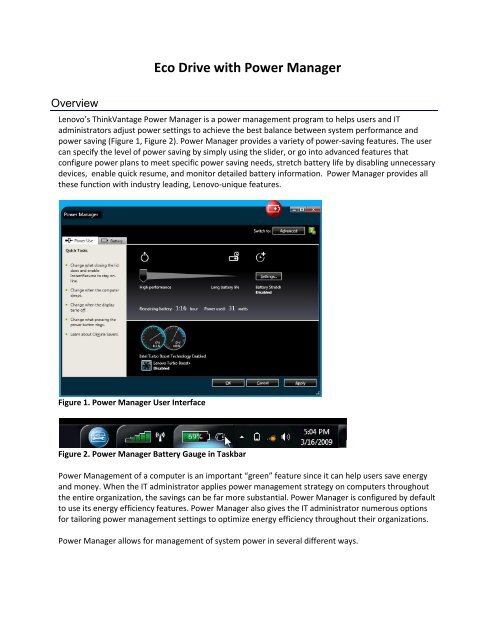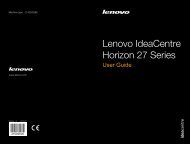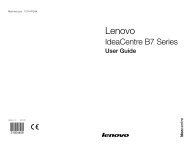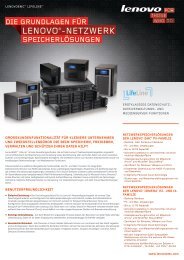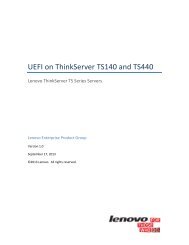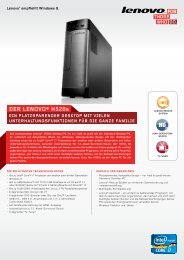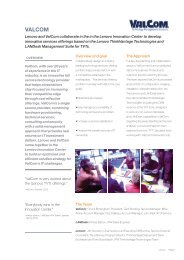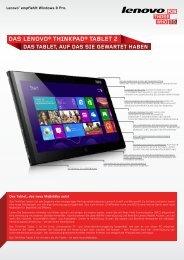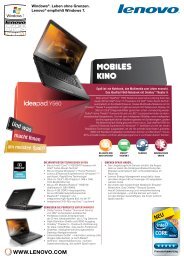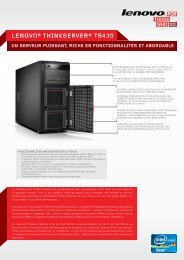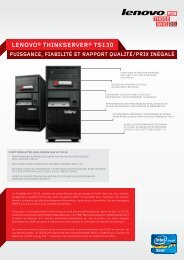Eco Drive with Power Manager - Lenovo
Eco Drive with Power Manager - Lenovo
Eco Drive with Power Manager - Lenovo
Create successful ePaper yourself
Turn your PDF publications into a flip-book with our unique Google optimized e-Paper software.
Overview<br />
<strong>Eco</strong> <strong>Drive</strong> <strong>with</strong> <strong>Power</strong> <strong>Manager</strong><br />
<strong>Lenovo</strong>’s ThinkVantage <strong>Power</strong> <strong>Manager</strong> is a power management program to helps users and IT<br />
administrators adjust power settings to achieve the best balance between system performance and<br />
power saving (Figure 1, Figure 2). <strong>Power</strong> <strong>Manager</strong> provides a variety of power-saving features. The user<br />
can specify the level of power saving by simply using the slider, or go into advanced features that<br />
configure power plans to meet specific power saving needs, stretch battery life by disabling unnecessary<br />
devices, enable quick resume, and monitor detailed battery information. <strong>Power</strong> <strong>Manager</strong> provides all<br />
these function <strong>with</strong> industry leading, <strong>Lenovo</strong>-unique features.<br />
Figure 1. <strong>Power</strong> <strong>Manager</strong> User Interface<br />
Figure 2. <strong>Power</strong> <strong>Manager</strong> Battery Gauge in Taskbar<br />
<strong>Power</strong> Management of a computer is an important “green” feature since it can help users save energy<br />
and money. When the IT administrator applies power management strategy on computers throughout<br />
the entire organization, the savings can be far more substantial. <strong>Power</strong> <strong>Manager</strong> is configured by default<br />
to use its energy efficiency features. <strong>Power</strong> <strong>Manager</strong> also gives the IT administrator numerous options<br />
for tailoring power management settings to optimize energy efficiency throughout their organizations.<br />
<strong>Power</strong> <strong>Manager</strong> allows for management of system power in several different ways.
First, the user and the user’s IT support desk may use the basic power management settings for “usage<br />
based” power savings such as turning off the monitor or going into sleep state after several minutes of<br />
inactivity.<br />
Second,<strong>Power</strong> <strong>Manager</strong> allows users and IT administrators the ability to set “time of day based” settings<br />
by using the “<strong>Power</strong> Agenda” feature (on select systems). This is important for peak power handling.<br />
Peak power refers to the time of day when there is the most demand for electricity, requiring more<br />
power from the electrical grid. <strong>Power</strong> plants are developed to meet peak power and often power is<br />
wasted during off-peak periods. Many power utility companies offer time-of-day electricity pricing and<br />
power agenda can alter power use based on that schedule to save energy at peak usage hours. Peak<br />
<strong>Power</strong> Scheduler in <strong>Power</strong> <strong>Manager</strong> details are presented later in this paper<br />
Third, the IT administrator may connect the ThinkPad into the Cisco EnergyWise enterprise power<br />
management solution that manages power use across the entire enterprise. Cisco EnergyWise details<br />
are presented later in this paper. The <strong>Lenovo</strong> ThinkPad is the first computer product to support Cisco<br />
EnergyWise.<br />
ThinkPad and “SmartGrid”<br />
<strong>Power</strong> manager has many “Smart Grid” technologies built in. IT Administrators may “push” power<br />
settings out to their user communities via “Active Directory”, “LanDesk”, and Cisco “EnergyWise”<br />
technologies.<br />
As is mentioned above, sleep and the ability to turn off the display is important to save power. Windows<br />
has features to automatically place into sleep/hibernation modes, or power off the display after a period<br />
of user inactivity. <strong>Power</strong> <strong>Manager</strong> goes beyond this by enabling the user to schedule power actions by<br />
creating power agendas to meet the specific needs. With <strong>Power</strong> <strong>Manager</strong>, users have not only sleep and<br />
display off timers, but also can change the display brightness, power plan switch, and Peak <strong>Power</strong><br />
Scheduler can be scheduled activated. Peak <strong>Power</strong> Scheduler is described in the next chapter.<br />
<strong>Power</strong> <strong>Manager</strong> also enables an IT administrator to deploy a power agenda by Active Directory as shown<br />
in Figure 3. The IT administrator can update the power agenda settings of client computers remotely<br />
and the users of client computers can have those power agenda work automatically <strong>with</strong>out configuring<br />
power agendas by themselves.
Figure 3. <strong>Power</strong> Agenda deployment<br />
Peak <strong>Power</strong> Handling<br />
Peak power is the maximum level of energy demand on the power company “grid.” <strong>Power</strong> plants are<br />
developed to meet the peak power demand. The amount of electrical energy demand varies over time<br />
and depends on weather, but is often high during midday as shown in the picture 2. Nuclear power<br />
generation is constantly available and is used throughout the day. During midday, oil, LNG, or gas are<br />
more used in power plant to meet peak power, and results in large CO2 emissions during midday as<br />
show in the Figure 4 and Figure 5. Reducing peak power leads to less fossil fuel consumption and peak<br />
hour power cost.
Figure 4. Daily power usage<br />
Figure 5. Daily energy type usage<br />
ThinkPad batteries can be used for energy storage to reduce peak power. Electrical energy is stored<br />
during the night and the stores are used at peak time as shown in the Figure 6. In <strong>Power</strong> <strong>Manager</strong>,<br />
“Peak <strong>Power</strong> Scheduler” is offered to do this as shown in the Figure 7. This is possible because<br />
ThinkPad hardware and embedded controller is designed to have ability to discharge battery even<br />
when AC adapter is connected.<br />
Figure 6. How Peak <strong>Power</strong> Scheduler works
Figure 7. Peak <strong>Power</strong> Scheduler User Interface<br />
Cisco EnergyWise<br />
Cisco EnergyWise is an IOS based software application that allows Cisco networks to control and<br />
perform energy management. The Cisco EnergyWise software enables customers to monitor, control<br />
and report on the energy use of building equipment and IT devices using a Cisco EnergyWise enabled<br />
network. More importantly, Cisco EnergyWise enables customers to set dynamic power policies that<br />
enable them to save money and reduce green house gas emissions when equipment is not in use.<br />
<strong>Lenovo</strong> and Cisco worked together to make ThinkPad the first computer product to support Cisco<br />
EnergyWise. The ThinkPad has the ability to measure its power consumed and the IT administrator is<br />
able to monitor actual power consumption of ThinkPad as shown in the Figure 8. Most common power<br />
monitors in the world are not based on measured power consumption, but are based on prediction. The<br />
actual data the ThinkPad provides will allow the IT administrator to know accurate power costs and help<br />
determine the proper action. Also, the IT administrator is able to place ThinkPad into sleep, hibernation<br />
and shutdown together <strong>with</strong> all other endpoints connected to Cisco network.
Figure 8. Cisco EnergyWise and ThinkPad<br />
Discussion<br />
Three green technologies mentioned in this paper in <strong>Lenovo</strong> <strong>Power</strong> <strong>Manager</strong> allow users and enterprise<br />
customers to better manage their power utilization. These technologies are very helpful not only for<br />
“green,” but also for power crisis management. Recently, there have been cases where power load<br />
demand exceeds power generation capacity. In 2007, a power crisis happened in California due to heat<br />
wave. In March 2011, the tragic earthquake in Japan damaged nuclear energy plant, and many cities in<br />
Japan are still facing severe power shortages. We believe that our green technology can help customers<br />
in through difficult times like these.<br />
Often times the greenest energy sources are intermittent (such as solar in the daytime, or wind when it<br />
is windy), and the technology in ThinkPads can help balance out our energy use.
Resources<br />
ENERGY STAR® Program Requirements for Computers<br />
http://www.energystar.gov/<br />
Cisco EnergyWise<br />
http://developer.cisco.com/web/esdk/home<br />
Biography<br />
Takumi Imai<br />
Takumi Imai lives and works for <strong>Lenovo</strong> in the Tokyo area of Japan. He has a M.S. in Robotics<br />
Engineering from The University of Tokyo. As a <strong>Lenovo</strong> Staff SW Engineer, he currently architects and<br />
develops software for ThinkVantage <strong>Power</strong> <strong>Manager</strong> (along <strong>with</strong> a group of highly talented co-workers).<br />
Imai-san is also a member of the ThinkPad “Green” team.<br />
E-mail: mc700444@lenovo.com


